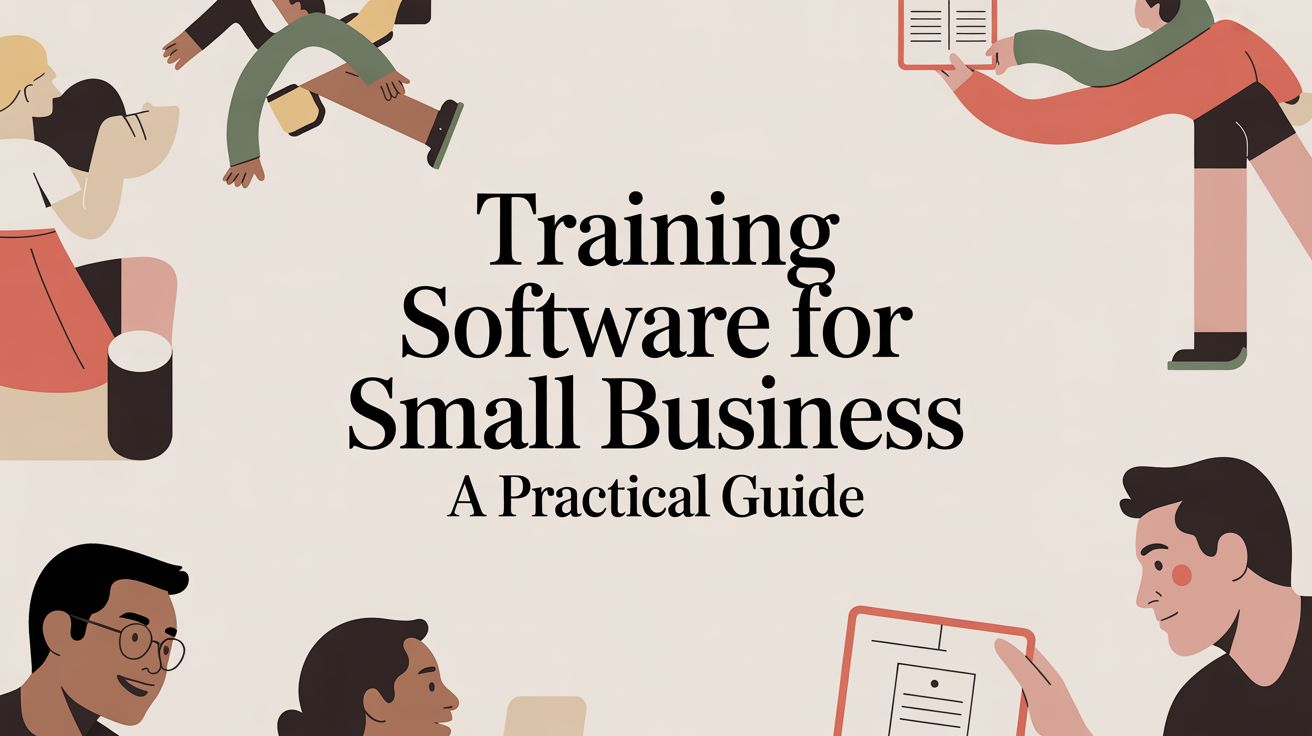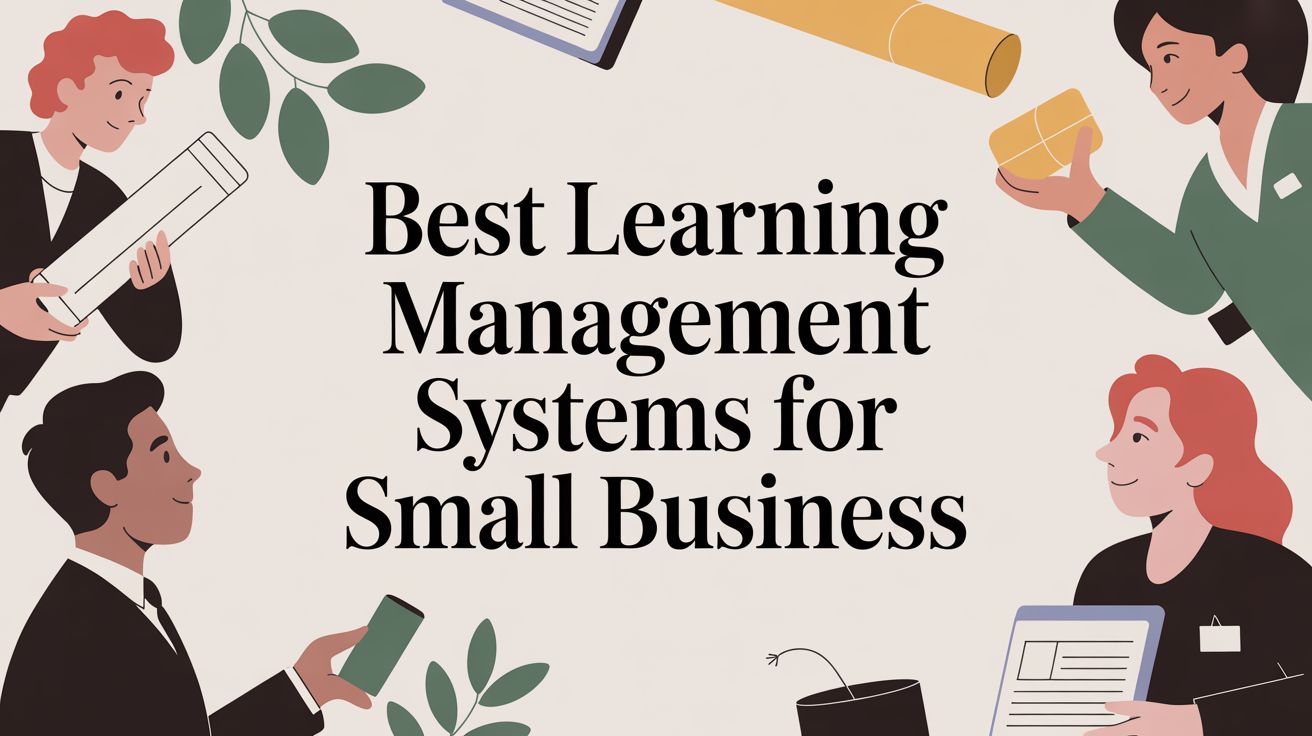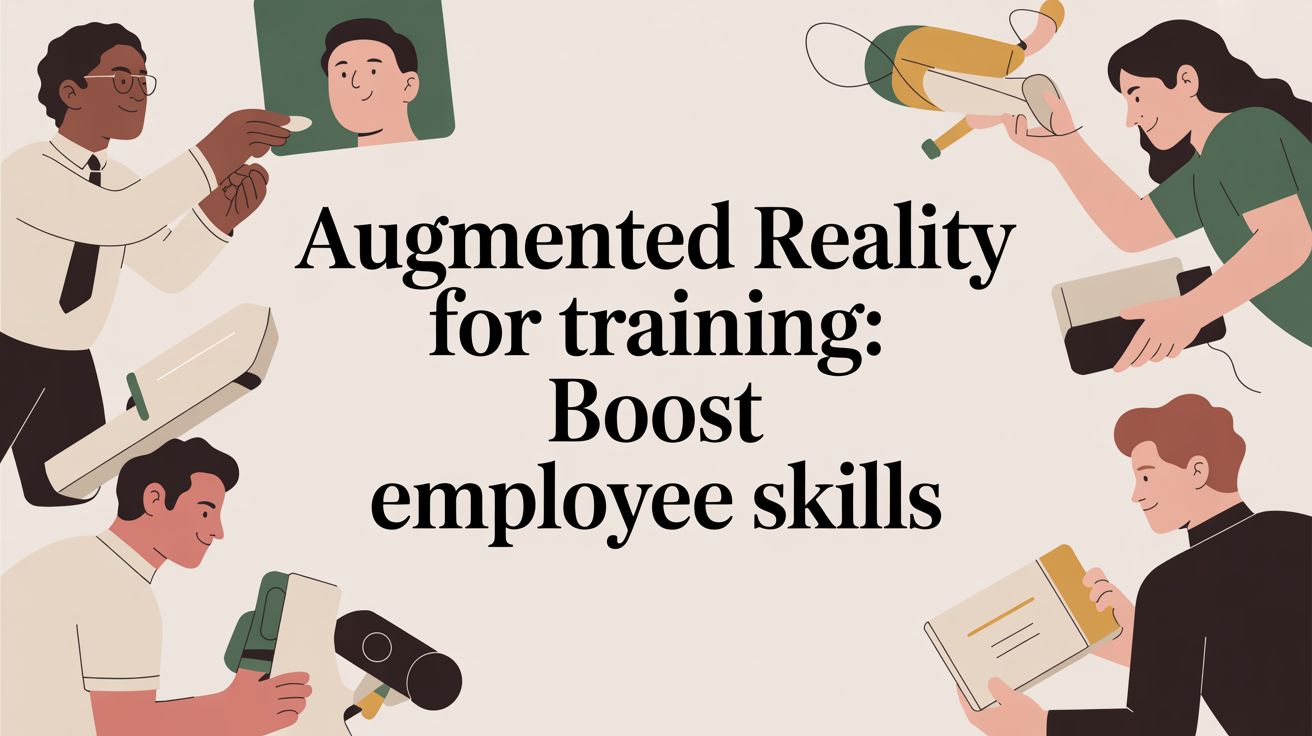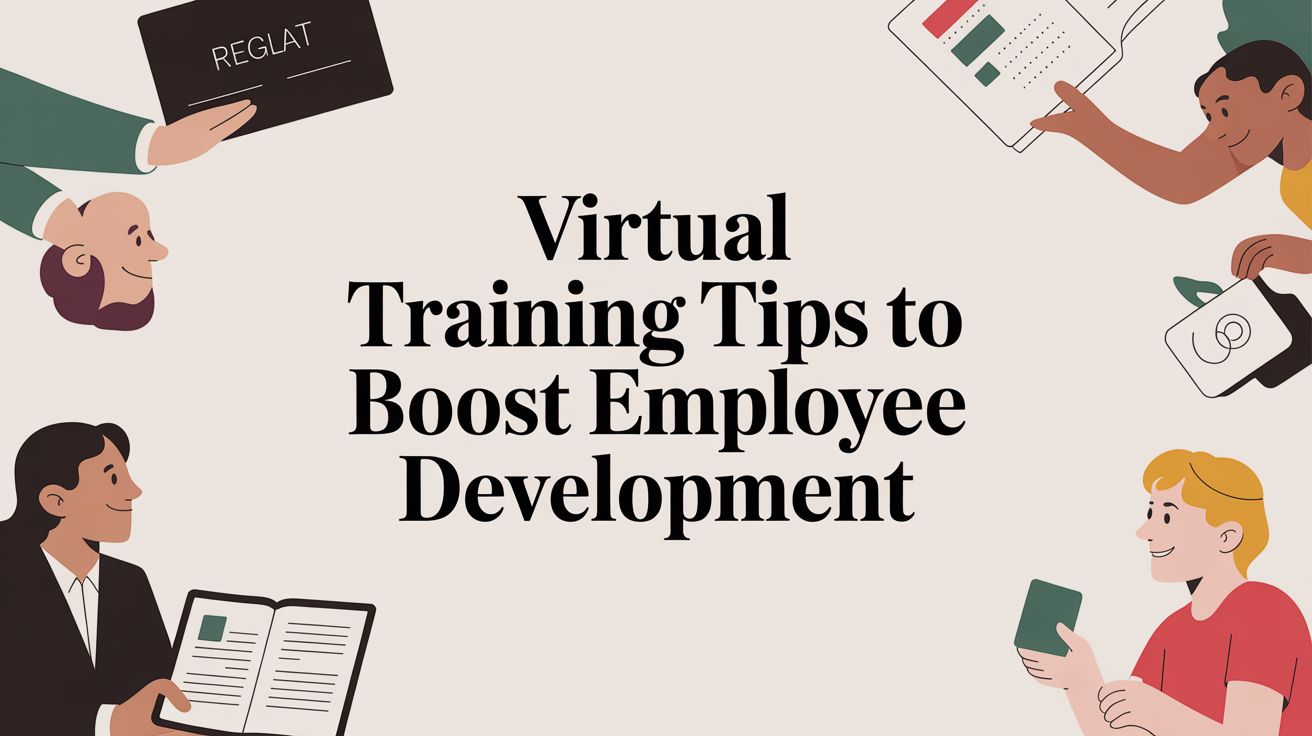Choosing Delivery Methods in Training

Picking the right delivery method for your training program isn't just about logistics. It's a strategic move that can make or break how well your team engages, how much they remember, and ultimately, how your business performs. The way you deliver the content is just as crucial as the content itself.
Why Your Training Delivery Method Is Key to Success
Companies are pouring more money into employee development than ever before, but the return on that investment often comes down to one thing: how the training is delivered. A one-size-fits-all approach just doesn't cut it anymore, especially with teams scattered across offices, homes, and everywhere in between.
The proof is in the numbers. The global workplace training market is booming for a reason. Businesses that invest in comprehensive training aren't just ticking a box—they're seeing real results. We're talking up to 17% higher productivity and a whopping 21% greater profitability compared to companies that skimp on training. You can dig deeper into these employee training trends and data insights to see the full picture.
This guide will walk you through the main training delivery methods out there and give you a practical way to choose the best fit. Once you understand what each approach brings to the table, you can build a training strategy that truly connects with your team and drives your company forward.
The Core Training Delivery Methods
First things first, let's get familiar with the main ways you can deliver training. Each has its own flavor, offering a different mix of interaction, flexibility, and scale. Think of them as different tools in your training toolkit.
-
Instructor-Led Training (ILT): This is the traditional classroom experience we all know. You've got an instructor at the front of the room, leading a group of learners in real-time. It’s fantastic for hands-on practice, group discussions, and getting immediate answers to questions.
-
Virtual Instructor-Led Training (VILT): Take the live classroom and move it online. Using tools like Zoom or Microsoft Teams, an instructor leads a session for participants who can be anywhere in the world. You get the real-time interaction of ILT without the travel costs.
-
Hybrid & Blended Models: These are the mashups. Hybrid training brings in-person and remote employees into the same live session. Blended learning is a bit different; it mixes live training (either in-person or virtual) with self-paced online modules that learners complete on their own time.
To give you a quick snapshot, here’s how these methods stack up against each other.
At-a-Glance Training Delivery Methods
| Delivery Method | Key Feature | Best For |
|---|---|---|
| Instructor-Led Training (ILT) | Face-to-face, real-time interaction in a physical classroom. | Complex skills, team-building, hands-on practice. |
| Virtual Instructor-Led Training (VILT) | Live, synchronous sessions conducted entirely online. | Geographically dispersed teams, consistent delivery across locations. |
| Hybrid & Blended Models | A mix of live, self-paced, in-person, and online elements. | Flexible learning paths, accommodating diverse schedules and learning styles. |
Choosing the right combination is what turns a good training program into a great one. In the next sections, we'll dive deeper into each of these methods, exploring their pros and cons to help you build a program that really works.
The Enduring Power of In-Person Training

Even with all the digital tools at our fingertips, there's something special about learning in a room with other people. Instructor-Led Training (ILT) is the classic, high-touch approach, and for good reason—it works. There's a certain energy you get from face-to-face interaction that a screen just can’t replicate.
This method is all about human connection. It’s where spontaneous questions lead to fascinating detours, where networking happens organically over a cup of coffee, and where an instructor can read the room. They can see the "aha!" moments and the subtle signs of confusion, adjusting their approach on the fly. That real-time, dynamic feedback loop is what makes ILT the gold standard for so many learning objectives.
When Face-to-Face Is the Best Fit
In-person training is more than just a lecture; it's a shared experience. It truly excels when the training requires hands-on practice, nuanced communication, or building genuine team bonds.
It’s the go-to choice for scenarios like these:
- Teaching Complex Skills: Think about training someone on intricate machinery, a sophisticated piece of software, or a delicate medical procedure. Nothing beats having an expert right there to provide direct supervision and immediate correction.
- Developing Leadership and Soft Skills: How do you get better at negotiation, public speaking, or resolving conflict? You practice. ILT provides a safe space for live role-playing and group exercises that build real confidence.
- Building Team Cohesion: Bringing a new project team or a cohort of recent hires together in one place for onboarding does more than just transfer knowledge. It builds personal rapport and a shared sense of mission that’s tough to forge through video calls.
Getting people away from the constant dings and distractions of their daily workspace creates a focused, immersive environment. This dedicated time and space naturally lead to deeper engagement and better knowledge retention. To get a better handle on this, you can explore the core principles of effective instructor-led training and how to make the most of it.
Pro Tip: The magic of ILT can quickly get bogged down by logistics. A solid training management system (TMS) is your best friend here. It handles the headaches of scheduling, room booking, and registrations, so your instructors can focus on what they do best—teaching.
Weighing the Pros and Cons
Let's be realistic—no single training method is a silver bullet. While ILT delivers an unparalleled level of engagement, it also comes with a unique set of practical challenges. It’s crucial to weigh its powerful benefits against the realities of your budget and organizational needs.
Advantages of ILT:
- High-Level Engagement: With direct access to instructors and peers, learners stay tuned in and actively participate.
- Instant Feedback and Clarification: Questions are answered the moment they arise, and misunderstandings are cleared up immediately.
- Natural Team Building: Working and learning together in a shared space fosters professional relationships and strengthens team bonds.
Disadvantages of ILT:
- Higher Costs: You have to account for instructor fees, venue rentals, travel, and materials, which can add up.
- Logistical Hurdles: Juggling schedules, locations, and resources for a group of people is a significant administrative task.
- Scalability Challenges: It's difficult and expensive to deliver the exact same in-person experience to a large, geographically scattered workforce.
While those logistical hurdles are very real, modern tools can take a lot of the pain out of the process. A robust training management system like Coursebricks, for instance, is built to automate the administrative side of instructor-led training—from bookings to invoicing—making ILT a much more manageable and powerful part of your training strategy.
2. Going Digital with Virtual Instructor-Led Training (VILT)

As teams spread out across cities, countries, and continents, the classic classroom model has evolved. Virtual Instructor-Led Training (VILT) has stepped up to fill the gap, offering a powerful way to bring people together for live, interactive learning.
This isn't just a one-way webinar where someone talks at an audience. True VILT is a synchronous, dynamic event. It uses technology to recreate the energy of an in-person workshop, with everyone—instructor and learners—interacting in real-time. Imagine video conferencing for face-to-face discussions, digital whiteboards for brainstorming, and breakout rooms for focused group work. It’s the classroom, just without the travel.
Why Teams Are Embracing Virtual Training
Right off the bat, the biggest wins with virtual training are its incredible reach and cost savings. You can completely wipe out the hefty costs of travel, hotels, and venue rentals. Suddenly, you can deliver the exact same high-quality training to an employee in London, another in Singapore, and a third working from their home office in Omaha.
This model also offers a ton of flexibility. Instead of pulling people away for a full day, you can schedule shorter, more focused sessions that fit neatly into their work schedules. And one of my favorite perks? You can record every session. This builds an instant library of on-demand content for anyone who missed it or just needs a quick refresher down the road.
If you want to dig deeper, our complete guide to virtual training is a great place to start.
The Hurdles of the Virtual Classroom
Of course, it’s not without its challenges. The number one enemy of any virtual trainer is distraction. When your learners are a single click away from their email inbox, social media, or another project, you have to work much harder to hold their attention.
We’ve all heard of "Zoom fatigue," and it's a very real thing. To combat it, facilitators need to be more than just presenters; they need to be masters of engagement. It’s also important to remember that skills don’t always transfer directly. A trainer who can command a physical room with their presence might need a whole new set of skills to read digital body language and keep the energy high online.
Finding ways to keep people locked in is the secret sauce. You can explore some effective strategies for student engagement in online learning to get some great ideas.
Key Takeaway: The success of VILT hinges entirely on active participation. You can’t just lecture. The best sessions are packed with polls, Q&A, hands-on exercises, and frequent short breaks to keep everyone mentally and physically engaged.
When done right, VILT is every bit as impactful as being in the same room. It offers a blend of scalability and personal connection that makes it an essential part of any modern training strategy. The key is to design for interaction from the ground up.
Breaking Down Blended and Hybrid Training
When you're trying to build a modern training program, you'll quickly run into two popular approaches: blended and hybrid learning. They sound similar, but they solve different problems.
Think of blended learning as a learning path with different stops along the way. Learners might complete some asynchronous, self-paced online modules on their own time, and then everyone comes together for a live, instructor-led session—either in-person or virtual. It’s a sequence of different formats.

Hybrid learning, on the other hand, is all about one single, live event. The key difference is that some people are physically in the room, while others join remotely at the same time. Everyone participates synchronously in one shared experience.
So, a blended model could be a sales team completing an e-learning course on product features before they all meet up for a hands-on workshop to practice their sales pitches. A hybrid model is that same workshop happening with half the team in the conference room and the other half dialing in from their home offices.
To put it another way, blended learning is like a multi-course meal, where you get an appetizer on your own before the main course is served to everyone together. Hybrid learning is more like a live-audience cooking show where you can either be in the studio or watch from home, but the show happens at the same time for everyone.
What Makes These Models So Effective?
Combining self-paced and live elements is a powerful trend for a reason. Done right, these models give you the best of both worlds.
- Flexibility & Engagement: Learners can tackle dense material at their own pace and then come to the live session ready for high-value, real-time interaction.
- Collaboration: Live discussions and group activities, whether in-person or virtual, create a strong sense of community and encourage peer-to-peer learning.
- Reinforced Learning: Key concepts are driven home by being presented across different formats, which helps with retention.
- Accountability: Scheduled live sessions act as checkpoints, which dramatically increases course completion rates compared to purely self-paced programs.
But let's be realistic. Mixing and matching formats brings a new level of logistical and technical complexity that can easily overwhelm even the most organized training administrator.
The Headaches: Logistics and Technology
Pulling off a seamless blended or hybrid program requires a serious command center. Without a robust Training Management System (TMS), you’re signing up for a lot of manual work and potential chaos.
Here’s what you’re up against:
- Scheduling nightmares trying to coordinate sessions across different time zones and locations without double-booking instructors or rooms.
- Tech failures during a hybrid event—like bad audio, laggy video, or a weak network connection—that can completely derail the experience for remote attendees.
- Fragmented tracking when you have to manually piece together who completed the online modules and who showed up for the live session.
- Admin overload from sending endless reminders, confirmations, and follow-up emails, not to mention issuing certificates one by one.
Key Insight: A Training Management System like Coursebricks acts as your central hub for instructor-led events, automating all the moving parts. This frees you up to focus on creating a great learner experience instead of getting bogged down in coordination chaos.
For a deeper look at making live sessions click, check out our guide on how to manage interactive training, which shows how the right system handles the details for you.
A Real-World Example
A global consulting firm needed to deliver a new leadership program to 400 managers spread across five different regions.
Instead of flying everyone to one location, they used a blended approach. The managers first completed a series of self-paced online modules. Then, they all joined a single hybrid workshop, with some attending in-person at regional hubs and others joining online.
The result? They boosted program completion by 25% and slashed their travel budget by $50,000. This kind of success story shows why having a dedicated TMS to coordinate blended and hybrid courses isn't just a nice-to-have—it's essential.
How to Choose the Right Delivery Method
Choosing from the different delivery methods in training isn’t about finding a single “best” option. It’s about building the right strategy. The most successful training programs almost never stick to just one approach. Instead, they blend different methods to create a complete learning journey that actually hits its goals and connects with the audience.
So, where do you start? The decision really comes down to a few core questions. Answering them honestly will give you a clear framework and point you toward the right mix of in-person, virtual, and hybrid training for your specific needs. It's how you make sure your investment in training pays off with real, measurable results.
Analyze Your Learning Objectives
First things first: what do you want people to be able to do differently after the training is over? The skill itself is your biggest clue.
-
Hard Skills Training: If you're teaching someone to use complex software, follow a technical procedure, or operate a piece of machinery, there's no substitute for hands-on practice. This usually calls for an in-person session or a highly interactive virtual lab where people can get their questions answered on the spot.
-
Soft Skills Development: When you’re focused on things like leadership, communication, or negotiation, group dynamics are everything. Face-to-face workshops are fantastic for this, allowing for the subtle back-and-forth of role-playing and direct feedback that’s tough to capture through a screen.
Understand Your Audience
Next, think about who you're training. Where are they located, what are their roles, and how do they prefer to learn? A method that’s perfect for one group could fall completely flat with another.
Here are a few key things to consider about your learners:
- Geographic Distribution: Is everyone in the same office, or is your team scattered across the globe and multiple time zones? For a distributed workforce, virtual or hybrid training isn't just a nice-to-have; it's a logistical necessity.
- Tech-Savviness: How comfortable is your team with digital tools? Most people can handle a video call, but a sophisticated hybrid setup with multiple collaboration platforms might require a bit of a learning curve.
- Role and Schedule: Can you really pull your entire sales team off the floor for two straight days of training? Or would it be less disruptive—and more effective—to deliver that same content in shorter virtual bursts over a week?
Pro Tip: Don't guess what your learners want. A quick survey can give you incredible insight into their preferred learning styles and any tech hurdles they might be facing. This simple step helps you choose a delivery method they'll actually want to engage with.
Factor in Budget and Technology
Of course, practical constraints always play a part. Your budget and the technology you have on hand will naturally narrow your options and show you what’s truly possible.
In-person training, for instance, comes with costs for travel, venues, and physical materials. Virtual training cuts down on those expenses but requires a solid tech foundation, including reliable video conferencing software and good internet access for everyone involved.
Juggling all these different delivery methods in training—especially for live, instructor-led sessions—creates a lot of administrative work. This is where a dedicated system can be a lifesaver. A Training Management System (TMS) like Coursebricks is built to handle the scheduling, registration, and communication for in-person, virtual, and hybrid courses, making the whole process smoother for you and your learners.
Matching Training Goals to Delivery Methods
To bring all this together, think about how specific goals align with certain delivery methods. This table can act as a quick cheat sheet to point you in the right direction when you're making a decision.
| Training Goal | Primary Recommended Method | Secondary Method | Key Consideration |
|---|---|---|---|
| New Hire Onboarding | Blended Learning | In-Person (ILT) | Combine self-paced foundational knowledge with live sessions for culture and team building. |
| Technical Certification | Virtual (VILT) | In-Person (ILT) | VILT offers scalability, but complex hands-on skills may require an in-person component. |
| Leadership Development | In-Person (ILT) | Hybrid | The nuances of interpersonal skills are best taught face-to-face to build trust and rapport. |
| Compliance Training | Blended Learning | Virtual (VILT) | Use self-paced modules for core content and live VILT for Q&A and scenario discussions. |
Ultimately, this isn't about finding a perfect formula. It's about being intentional and choosing the tools that will best help your people learn, grow, and succeed in their roles.
Streamlining Live Training With a TMS
If you’ve ever tried to manage instructor-led, virtual, or hybrid training using a patchwork of spreadsheets and endless email threads, you know the pain. It's a fast track to administrative chaos. These complex, synchronous delivery methods in training have too many moving parts for manual tracking.
This is exactly where a Training Management System (TMS) steps in. Think of it as the mission control for the operational side of learning.
While a Learning Management System (LMS) is fantastic for delivering and tracking self-paced e-learning, a TMS is specifically designed for the complexities of live training. Its entire purpose is to wrangle the real-time logistics of instructor-led events. To see how these two systems tackle different challenges, you can explore this detailed comparison of the best LMS for corporate training.
The Power of Centralized Operations
A TMS brings all the scattered pieces of your live training programs into one organized dashboard. It's designed to lift the administrative weight off your shoulders so you can focus on what actually matters: creating a great learning experience.
Imagine being able to manage all of this from one place, without breaking a sweat:
- Scheduling complex multi-day or multi-location sessions without double-booking a room or an instructor.
- Managing instructor availability, assignments, and resource bookings (like projectors or lab equipment).
- Tracking attendance seamlessly, whether learners are in the room or joining online.
- Automating the entire registration workflow, from sign-ups to confirmation emails and pre-course reminders.
To really get why a TMS is so effective, it helps to have a basic understanding of workflow automation. These systems are experts at turning time-consuming manual chores into simple, set-and-forget processes. By automating the backend administration, you slash the risk of human error and free up a shocking amount of time.
Key Insight: A TMS isn't just a time-saver; it’s a focus-shifter. By getting the operational grind off your plate, you can pour that energy back into improving course content, supporting instructors, and engaging with your learners.
Ultimately, using a dedicated system to manage the different delivery methods in training—especially the live ones—ensures a smooth, professional, and frustration-free experience for everyone involved.
Ready to explore Coursebricks?
Manage training programs, automate emails, and generate detailed reports — all in one place.


























